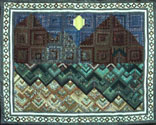|
|
|
Years later and with her Mom’s watchful eye,
Flavin made her first quilting stitches.
In 1974 and 1975, Flavin and Nonnie worked on joint quilting projects. Nonnie had set a goal to make a patchwork quilt for each of her 18 grandchildren. Flavin and her sister, Londa, help Nonnie achieve that mission. A neighbor on an adjacent farm, Vonda Lee Waldrep, showed them a beautiful Log Cabin she had hand-pieced and quilted. With that introduction, Flavin machine-pieced similar Log Cabin blocks. First, she made a few pillows. Then, needing two tablecloths, she stitched them Log Cabin-style and quilted the blocks into straight furrows without batting between the layers. They worked like a charm. Continuing to quilt Log Cabin patchwork in the
style
Mrs.
Waldrep
had taught her, Flavin eventually showed her quilts
at the Southern Quilt Symposium in Chattanooga, Tennessee.
There she saw the work of other quilters, including Bets Ramsey
and Mildred Locke.
Studying
their work helped Flavin see that Log Cabin could be approached in a
variety of ways.
Flavin
realized Log Cabin patchwork could become a design foundation that
offered versatile pattern options, depth, movement and opportunities for
color play. In 1979, two of Flavin’s Log Cabin landscape
quilts were shown at the National Quilt Association Show in Fort Wayne,
Indiana.
From that
exposure, an opportunity came to teach at the Tropical Florida Quilt
Conference in Miami,
Florida in 1980. Since that time,
teaching work Flavin began teaching workshops in Log Cabin, Patchwork Clothing, Color and Design and Creative Geometric Patchwork in 1980. The joys of teaching in Flavin’s view are in sharing ideas, helping students expand their knowledge, and in motivating others to create quilts from within themselves. She feels her best work has come from creative problem-solving, yet she frequently relies on her quilting heritage to keep a scrappy, spontaneous look. She has an appreciation for her past as she continues to design, quilt and teach the art she began to love as a child. To read an essay about Flavin's mother, Nonnie Williams, CLICK HERE. |




